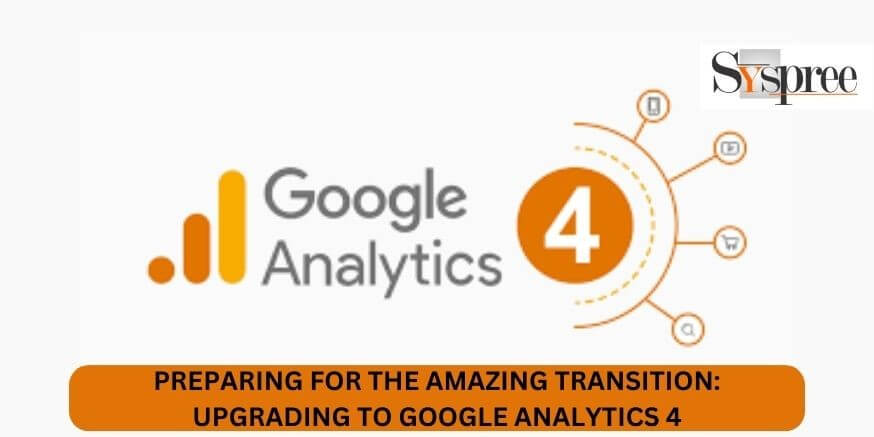Google recently announced their web analytics software suite, Universal Analytics (UA), will be replaced with Google Analytics 4 (GA4) beginning on July 1, 2023. A leading digital marketing company states that Web analytics is essential for marketers to comprehend to improve their app, website or user experience for their customers.
Web analytics enable marketers to design strategies driven by data, and now thanks to Google Analytics 4, it will get even more effective. What is more appealing in Google Analytics 4 when compared to Universal Analytics? There are various features Google Analytics 4 offers that enable users to be more in touch with their customers.
GA4 concentrates more on events-based data than the session-based information that UA concentrates on. In addition, GA4 keep track of the most basic web page views and clicks. It also lets users monitor anything and then use that information to dissect each layer to understand how users interact with your website or application truly.
GA4 offers 50 different parameters through which the data can be examined, and they are likely to change the method they collect information. There avoid many privacy concerns that GA4 can avoid because they rely on first-party cookies, as opposed to the third-party cookies that UA utilizes.
GA4 utilizes Artificial Intelligence (AI) to fill in every gap in the consent protocols for cookies and provide greater privacy. To remain ahead of the game, GA4 has taken the initiative to achieve its long-term goal of not letting cookies hinder them from obtaining the most accurate data it can. Since a few web browsers have banned cookies and are planning to block third-party cookies, GA4 is ready to adjust ASAP.
Google has realized the value in launching Google Analytics 4, their next analytics software, and since they’ll end tracking the analytics of Universal Analytics shortly, it’s best to be prepared for changes. GA4 comes with a blank page of the paper. This is a first for the field; therefore, the faster you can collect data that can feed the analytics suite, the better off you’ll be in the short and the long term.
Google Analytics 4 is an effective marketing tool that provides insights that can help you make better decisions regarding your marketing. Here’s what you need to be aware of GA4.
Key Takeaways
- Google Analytics 4 (GA4) replaces Universal Analytics (UA) as the latest Web Analytics software developed by Google with more features and capabilities.
- GA4 is a system that focuses on the event rather than session-based information, permitting users to monitor and analyze the user’s actions at a detailed level.
- GA4 utilizes Artificial Intelligence (AI) to bridge data gaps caused by privacy laws and the blocking of cookies, thereby providing marketers with a greater knowledge of the behaviour of users.
- User interfaces and the data structure of GA4 differ from the previous version, and the focus is shifting to user-centric data and reporting.
- GA4 provides advantages like enhanced tracking of customer journeys, improved user interaction analytics, more effective ads targeting the right audience, and a simplified goal and event set-up. GA4 has enhanced privacy and tracking features and improved visualizations and reporting capabilities.
What is Google Analytics 4?
Google self-describes the new Google Analytics goal as the next technological method of “privacy-first” tracking, x-channel measurement, and AI predictive data based on AI all in one. This new Analytics will provide information on web traffic and user behaviour without relying on “hits” generated from every page thanks to Google’s cutting-edge machine learning techniques.
Google Analytics 4 is built on the same platform used for”App + Web,” the “App + Web” system they introduced in 2019. This App + Web variant of Analytics focused on cross-channel information, allowing marketers to monitor users across applications, software and websites. Allow a brilliant website development company to guide you about GA4.
Its principal goal is to change the way data is presented to be focused on the user and their journey from the first visit until the final conversion. Plus, GA4 is focused on “events.” These events are the main way data is displayed in the new version of Google Analytics.
In addition, the machine-learning technology of this new Analytics will allow it to fill in the gaps that businesses can’t comprehend their entire customer base due to people who choose not to use cookies and data gathering.
Users of the Internet and browser vendors are becoming more cautious regarding using Analytics to monitor sessions or track users using cookies. For instance, Mozilla Firefox has moved to stop Analytics, and many websites are beginning to ask for consent from visitors to determine the scope of their Analytics tracking.
The most recent privacy laws (such the GDPR and CCPA) and the declining accuracy of traditional analytics are the main drivers of the need for products like Google Analytics 4. Businesses that utilize the old Universal Google Analytics could often have problems with missing or inaccurate information due to the cookie consent requirements imposed under these new laws.
What does the latest model mean for marketing? How does it compare to the old version?

Google Analytics Vs Universal Analytics
For tracking user interactions across web domains, mobile apps, and offline APIs, millions of businesses and websites utilise Google Analytics. The majority of businesses use this software as one that allows them to track the number of visitors they see, monitor key marketing avenues, as well as evaluate their most important KPIs.
With Google Analytics 4, Google offers a new version different from traditional “universal” Analytics. The latest version of Google Analytics 4 has many important features that make it different from the older version.
The most creative web development company in Mumbai believes that one of the most significant distinctions is the brand new data modeling feature, which utilizes AI to fill in the data gaps, where traditional Analytics could be blocked through cookie-consent rules, a lack of JavaScript and the focus on privacy. In addition, the interface for users of the latest default Google Analytics is very different. Here’s a look at the major distinctions.
Google Analytics 4: What’s Changed?
There have been significant changes. GA4 has a vastly differing data structure, as does the data collection. Today, everything is built around events and users instead of sessions, which is what we’ve used to.
An event-based model interprets every interaction of a user as a separate event. This is significant as previously; we used an approach based on sessions that group user interactions within a certain period. Let the best digital marketing agency Singapore assist you in understanding the significant changes in analytics.
Shifting events from sessions provide significant benefits for marketers, like cross-platform analysis and the ability to perform pathing analysis. In converting towards an event-driven model, GA4 is more adaptable and better at predicting the behaviour of users.
- It’s designed with machine learning being the principal measure of data. It uses “modelling”, which can be extrapolated from available data and create assumptions about user behaviour and website traffic. The brand new AI-driven “Insights” function is intended to highlight relevant information automatically for marketers.
- It focuses on giving marketers a “more complete understanding of the customer journey across devices.” And it’s more focused on measuring an end-to-end shopper journey and not just individual metrics across devices/pages/segments.
- It’s made to be “future secure” and operate in a future without cookies or any other identifying information.
- Google Analytics 4 features “data streams” instead of the views and segments used by previous Universal Analytics properties.
- There isn’t a “view” level in GA4. Unlike the famed three layers of the conventional Universal Analytics (Account Property, Account, and View), GA4 simply offers two: Account and Property.
- While “event monitoring” in the old Analytics required modifications to Analytics codes and the gtag.js script. According to Google Analytics 4, events in the UI can be edited, tracked, and tuned.
- This includes actions like clicks, page scrolls and many more.
The GA4 has been upgraded to include new capabilities. GA4
- Marketers may use GA4 to change, improve, and fine-tune how events are logged in their analytics without changing the on-site code.
- Data Import can now import an array of data from other sources (like apps, for instance) in one property.
- Cross-domain tracking that doesn’t require code changes can be accomplished inside the UI.
- The “Life cycle report” appears to be one of the most significant shifts in Analytics and is focused on the user journey. Additionally, “templated reports for funnels used by e-commerce” allow marketers to visualize and display the data, a previously only feature in Analytics 360 accounts.
Advantages of Google Analytics 4

Advantages of Google Analytics 4
On the 14th of October 2020, Google announced the launch of Google Analytics 4. Google Analytics 4. The popular Analytics platform was built on App + Web, the App + Web platform, which was first released in beta 2019.
There are some significant distinctions between the old and the new version. The most notable is the application of machine learning to reveal information from the data gathered. Google claims that Google that the latest version of the software will be “privacy-centric through design”.
The best digital marketing agency Singapore states that as the gathering and sharing of data from individuals becomes more controlled, Google Analytics will be capable of filling in the gaps in information.
To be useful for website owners while reporting fewer and fewer data points, adjustments were required for Google Analytics. The top digital marketing company shares some of the features and advantages of GA4 in greater depth:
1. Improved Customer Journey Tracking
Google Analytics has changed how it structures its reports in its user interface. It has changed its fundamentals. The emphasis has shifted away from metrics easily broken down by platform or device, like sessions. The focus is now on user interactions, which are now recorded exclusively as events.
2. Improved user engagement analysis

Improved user engagement analysis
In addition to being capable of aggregating and collecting more information, Google has made it easier for analysts and marketers to look into user-centric reports by aligning the report menu sections to the user journey.
Google eliminated the Bounce Rate measurement and has replaced it with several more efficient user engagement metrics. This new set of engagement indicators, when combined with the pre-configured scroll videos, outbound clicks, and events to download files, should allow you to know if your content is engaging or whether users are engaged in the content.
3. A larger audience for your advertising campaigns
GA4 is equipped with better measurement tools and more powerful tools for analysts and integrations, which means stronger customers for marketing campaigns, resulting in a higher ROI for advertising spend.
Before GA4 is released, optimising your ad spend for these types of user experiences will be difficult – not the least because you’d struggle to link these various platforms and devices. The best website development company states If you set up your applications and web pages properly, you can weave user journeys and prevent the waste of your advertising budget.
4. Intelligent Approach

Intelligent Approach
A more intelligent approach to user privacy and tracking features, as well as tracking Google Analytics 4 gives you and your customers more granular with more precise and accurate control of the personal information being collected and how it is used to help you meet current and future privacy laws. For instance, with GA4, you can now exclude certain user events and properties from the personalization of ads.
5. Simplified Goals and Events Setup
It is known as ‘Event Editing and Synthesis as per Google. This allows users to refine the goal-tracking process and gather detailed behavioural information with no requirement to edit code and editing and optimizing goal setup.
The previously complex process is now simple and especially useful for transactions like checkout forms and application forms hosted on a sub-domain or a third-party website.
6. Reporting and visualisation enhanced.
A leading web development company in Mumbai believes that although the UI remains fairly identical on the platform, several new reporting and visualisation options exist. The existing visualisations and popular ones like ‘Real Time’ are enhanced and more enjoyable and engaging, but the visualisations for reporting can be a game changer.
Conclusion:
Better analytics insight can lead to better marketing choices.
GA4 is the latest version of analytics we’ve all been waiting for. It offers marketers greater flexibility and the ability to anticipate user behaviour while protecting privacy for users.
Once you’ve completed the process of learning, you’ve mastered GA4. Your flexibility and enhanced insight are worth the effort. If you liked this blog, be sure to read the previous blog post on The Power of Predictive Analytics in Driving Digital Marketing Success.








Very informative Thank you for sharing.
Hello Prachi, we are delighted to know that you found our blog informative. Do check out our website, we publish blogs based on Digital marketing often.